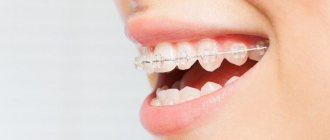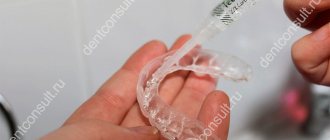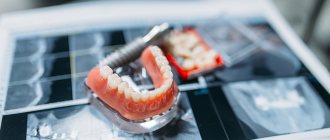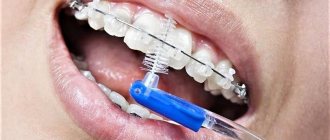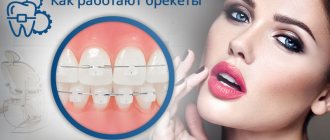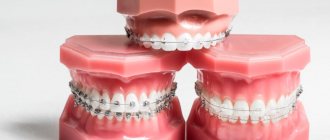Consultation with a doctor In case of malocclusion, the load on the teeth is distributed unequally, which accelerates their destruction, has a negative impact on the oval and facial features, and leads to the appearance of complexes that arise due to appearance. It is easier to change the position of a row or unit if you begin the correction in childhood. Which is better, dental braces or plates, depends on age and the degree of malocclusion. There are significant differences between both products; the orthodontist decides what is suitable for the patient.
What is the difference between the design of plates and braces?
Plates and braces are equally often used in pediatric orthodontics to correct bites and correct dentition.
They have significant design differences:
- Plate structures are a removable device for the correction of teeth occlusion disorders. Designed to correct minor malocclusions. They align separately located units well with each other. The devices cannot apply significant pressure to the jaw and teeth. Systems can only hold units and prevent them from bending. They can activate or inhibit jaw growth. These designs are worn for several hours during the day. It is possible to remove them from the oral cavity and install them yourself. They are removed during meals for hygiene purposes.
- Braces are a reliable orthodontic system and are non-removable structures. It cannot be removed by the patient himself. She copes with the correction of the most complex dental defects. The process of straightening teeth with systems is quite lengthy. It lasts up to several years, so a certain psychological attitude is required from the patient. The design consists of locks that are tightly attached to the teeth using special glue. They are fastened with a metal arch, which exerts significant pressure on the dental units and alveolar processes.
Only the orthodontist decides which design to choose for the patient to correct closure anomalies.
Metal children's braces
Metal children's braces are made of steel or alloys of several metals. This is an inexpensive design, which is famous for its high efficiency and, as a result, short wearing time. However, there are also disadvantages: the metal is very noticeable on the teeth, and can also cause significant inconvenience in the first weeks after installation. The oral mucosa may not be very friendly to metal. If the patient is allergic to metal, such braces can also be made from gold - it is hypoallergenic. Gold braces are more expensive and, apart from the absence of an allergic reaction, are no different from ordinary metal ones.
Metal braces can be ligature and self-regulating.
Differences in mechanism of action
Correction devices differ in their mechanism of action. Plate designs have one or more screws. They allow the growing jaw to expand, making room for permanent teeth. Metal arches correspond to the correct position of units in the dentition. The device cannot have a significant effect on the jaw. She cannot move dental units over a significant distance. It is used when there is no need to move it over long distances. It copes well with tilting and turning individual units. It is also used in young children to prevent malocclusion or to change the width of the growing palate.
Appliances for permanent wear have a wider range of possibilities for correcting malocclusion and dentition defects. The systems are able to place the tooth in the required place by pulling it out of the alveolus. Braces can immerse it deeper into the jaw, tilt it in the required direction, or rotate it relative to its axis. Unlike removable appliances, they are capable of correcting serious disorders of the dental system, and not just preventing them.
Stages of installing braces
The steps for getting braces include preparing your teeth through professional cleaning and treatment if necessary. Then the design is selected and manufactured, which is individual for each patient. After this, the doctor will install braces on all teeth, gluing or securing them in a special way. Then they will all be united by an arc, which will also be securely fastened.
The treatment process requires regular examinations by the orthodontist and periodic adjustments. Children generally do not require tooth extraction before getting braces. Adults, alas, most often have to say goodbye to one or more teeth.
Differences in indications for installation
Indications for the installation of both devices are violation of jaw closure, curvature of the dentition, displacement of individual dental units. However, they may differ in a number of parameters.
Indications for installing permanent structures:
- single defects of dental units;
- several crooked adjacent incisors;
- large gaps;
- anterior displacement of the incisors;
- various types of closure defects;
- impaired diction associated with malocclusion;
- deformations of the facial skeleton;
- crowding.
Indications for the installation of systems are severe pathologies of the dentofacial system, including in a fully formed jaw.
Indications for correction of anomalies with plates are as follows:
- beginning movement of teeth in the wrong direction;
- high probability of displacement of dental units;
- signs of initial jaw deformation;
- symptoms of pathological changes in the width of the palate.
Indications for the use of corrective plate devices are mild, incipient manifestations of pathology.
An alternative to braces is aligners.
In many cases, aligners can be used instead of inconvenient braces. Their key feature is that it is a removable structure made of transparent plastic that fits tightly to the teeth. This option is indispensable for those who, for some reason, cannot allow their appearance to change, because braces are clearly visible when talking and smiling, and they will have to be worn for several months, sometimes even up to 2 years. Of course, there are braces that are less noticeable, made of polymer or ceramic materials, as well as lingual braces, which are placed not on the outside, but on the inside of the dentition, but they cannot always be used, and their cost is much higher than usual.
Aligners are an analogue of braces, since they use the same general principle - applying constant pressure to the teeth in order to move them in the desired direction. The only difference is in the design, and as a result, in some functions and properties. Firstly, they are transparent, which makes them very unnoticeable from the outside, and secondly, they can generally be removed during an important meeting or photo shoot. To achieve the desired effect, aligners must be worn 20-22 hours a day, so you can always find time for meals or negotiations to remove the aligners for a while.
The difference between aligners and braces includes several important points:
- aesthetic – unlike braces, they are not visible,
- mechanics of impact – more evenly distributes pressure on each tooth,
- removable - they can be removed, hence there are fewer restrictions on food intake and easier hygiene,
- allergenicity - are made of hypoallergenic plastic, and braces are made of metal.
An orthodontist will help you decide to use aligners or braces in case of dental alignment, based on the specific clinical situation, individual characteristics and requirements of the patient.
Differences in age indications
The difference between a plate and braces is that they are used in different age groups of patients. Permanent systems are widely used only from the age of 12, when the jaw is already fully formed and all teeth have erupted. From the age of 14, adolescents can have lingual devices installed, this is explained by the difficulty of caring for them. Sometimes special fixed devices are installed starting from the age of seven. If they have severe bite defects that cannot be corrected later.
Plates are installed for children aged six to twelve years, during the replacement of the primary bite with a permanent one and the formation of the jaw bones. In adults, they are less effective, since a significant effect on formed bone structures is required. They use removable devices after treatment with permanent systems.
When should I put braces on my child?
On this issue, the opinions of professional orthodontists differ diametrically: some believe that the earlier treatment is started, the greater the chances of a successful result and the “less bloodshed” you will be able to manage. Of course, there is no talk of any real blood, unless the installation of an orthodontic structure requires cutting the frenulum, but we will have to talk about the inconveniences. Other experts believe that in order to correct both functional and aesthetic problems of the dentition, it is necessary to wait until the permanent bite is fully formed in order, firstly, to avoid relapses, and secondly, to convince the teenager of the need and involve him in conscious work on his health and appearance. The correct answer to the question “At what age do children get braces?” lies somewhere in the middle.
Installation of braces for children from 8 to 10 years old
If we are talking about violations of occlusion, that is, the closure of the dentition, the formation of a deliberately incorrect bite, or problems with teething, then it is really worth starting at a younger age. In childhood, the bones are softer and more mobile, therefore it is much easier to work on them; most likely, even braces will not be needed; an experienced specialist will be able to get by with removable plates and trainers, but parents will need to carry out educational work with the little patient and carefully monitor that he observed the wearing regime. From the age of 6, you can use an alternative system to braces, for example, removable aligners.
When is the best time to get braces for a child over 18 years of age?
As for unevenness, the unfolded position of the teeth in a row, crowding or enlarged teeth and diastemas, here it is really worth waiting for the full formation of the permanent bite and putting on braces; especially disciplined teenagers can, like real adults, undergo treatment with aligners that correct the bite no worse, and sometimes even better, than braces, but requiring strict adherence to the rules and recommendations of the doctor.
Pros and cons of orthodontic structures
Let's look at the positive and negative qualities of the two methods of bite correction.
Pros and cons of permanent devices
They have their pros and cons as any method of bite correction.
Braces for children have the following advantages:
- provide rapid correction of anomalies due to continuous, powerful impact;
- corrects complex, congenital defects;
- wide range of application by age;
- easy adaptation;
- do not provoke problems with diction;
- quick repair possible;
- the ability to move dental units in the desired direction.
These devices not only have advantages, they also have disadvantages.
These include:
- low aesthetics of metal devices;
- difficulties in caring for them;
- high price.
Despite the inconvenience of correction systems and other disadvantages, it is widely used among adolescents.
What is more expensive - braces or aligners?
In some individual cases, expensive branded aligners may be more expensive than cheap braces, especially with long-term treatment involving many stages. But if the comparison is made correctly, comparing cases of the same degree of complexity, then the difference in the price of braces or aligners will either be minimal, or even aligners will be more profitable.
Imported mouthguards from foreign manufacturers are more expensive. Our clinic cooperates with Star Smile, a leading domestic manufacturer of aligners, which, with completely similar quality, have a much lower price. This allows us to offer treatment for malocclusion using aligners at the most affordable prices.
Therefore, to the question: what to choose: braces or aligners? – our doctors answer unequivocally – choose aligners. This will provide greater comfort during treatment, better aesthetics and will be much more profitable.
Pros and cons of plates
They also have their advantages and disadvantages.
The advantages of this type of structure include:
- no labor-intensive care required;
- does not interfere with oral hygiene;
- removed for meals;
- atraumatic;
- easy adaptation;
- high efficiency in childhood;
- affordable price;
- are removed independently.
Orthodontic removable appliances have a few disadvantages.
These include:
- ineffectiveness of correction in adults;
- allergies are possible;
- severe anomalies are not corrected;
- fragility;
- If it breaks, it’s difficult to fix, you have to order a new one.
A number of positive qualities of plates for children ensure their widespread use in pediatric orthodontics.
Price difference
Permanent correction systems and measures for their installation and maintenance will cost the patient much more than corrective plates.
Here is the estimated cost of various types of structures per jaw:
- metal – 30,000 rubles;
- ceramic – 40,000 rubles;
- sapphire – 70 thousand rubles;
- sapphire with a white arc - 80,000 rubles;
- lingual – up to 100,000 rubles.
The cost of the structure itself is not the final price of the entire treatment. The price for all services for installation, activation of the device and its removal is separate. Various types of plate correctors cost from 20 to 50 thousand, depending on the model.
Choosing plates or braces is quite difficult for a non-specialist. The choice of a device for the correction of dentoalveolar anomalies is carried out only by an orthodontist, taking into account all the characteristics of the patient.
Hygiene and maintenance
In terms of ease of maintenance, the plates are unrivaled. The structure is simply removed and cleaned, as well as the dentition. All you need is an ordinary toothbrush, preferably with soft bristles, and an effective toothpaste.
In this regard, braces require more scrupulous care; the structure cannot be removed, so the entire cleansing ritual must be carried out very carefully so as not to damage anything.
The tools here are:
- A brush specially designed for this purpose.
- Fluoride-containing toothpaste with gentle characteristics.
- An irrigator that not only cleanses the oral cavity, but also massages the gums.
- Dental floss.
- Mouthwash with antibacterial properties.
Once every six months you will have to visit an orthodontist to undergo additional procedures to clean the oral cavity. During these visits, the progress of the treatment process is monitored.
